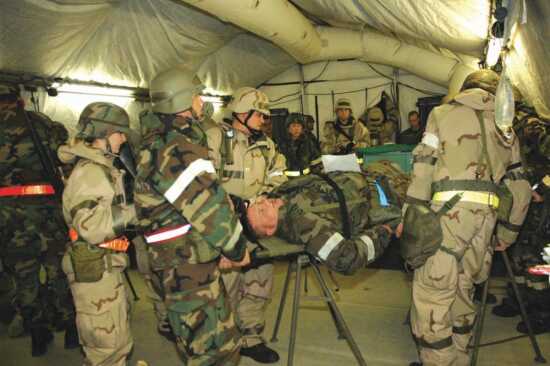Sharpshooter exercise tests medics for combat readiness

In a combat situation, the tent might get confused as anything from someone's living quarters to a fighter squadron's operations desk. The large, red cross on the roof provides the only break from its bland, outward appearance.
Inside these cramped quarters, the deployed medical facility takes on the appearance of a makeshift emergency room capable of packing its bags and moving anywhere around the world. Fielding a team of medical providers, this mini emergency room can deal with everything from bullet wounds and trauma cases to simple fractures or burns.
During the base's Sharpshooter combat readiness exercise Aug. 28 and 29, the 366th Medical Group set up a deployed medical facility -- DMF for short -- to train doctors and medical technicians here for what to expect during real world operations in places like Iraq and Afghanistan.
"Depending on your location, some of our medical capabilities may differ slightly," said Tech. Sgt. William Howard, 366th Aeromedical Dental Squadron. "For the most part, however, they mirror what we do stateside."
DMFs conduct basic life-saving procedures to treat and release patients with minor injuries and stabilizing people with more serious injuries, like chest wounds and head trauma, until they get airlifted to regional medical facilities for more extensive medical care.
Medical evaluators grade these Airmen on how they handle each situation and their knowledge of what care to provide. In addition the Airmen are also graded on survival responses, perimeter security and chemical, biological, radiological/ nuclear, and explosives detections and other functions.
"It provides realistic training as our medical mission does not change depending on where we are," Sergeant Howard said. "The training is always realistic."
Approximately 60 Airmen work together to keep the facility operational around the clock during the two-day exercise. The training they practice now gets a final grade in March 2008 during the 366th Fighter Wing's operational readiness inspection. This weeklong evaluation gives the wing a chance to demonstrate its combat prowess to representatives from Air Combat Command.
For people like Sergeant Howard, it's their chance to prove how this portable, compact emergency room can help save lives during combat operations anywhere around the world.
